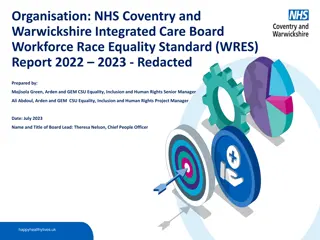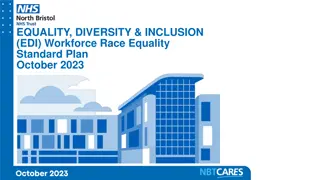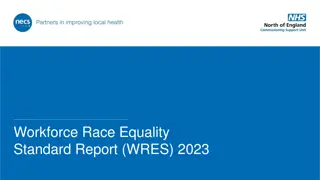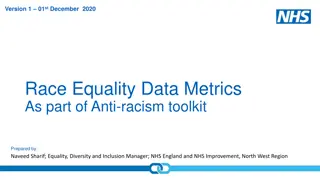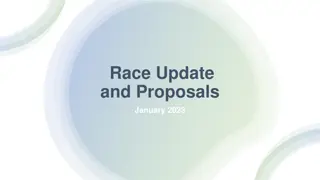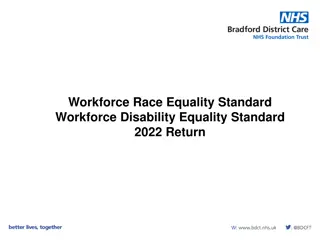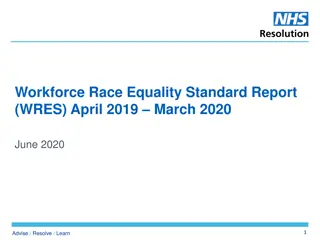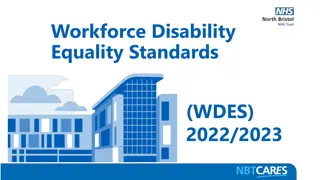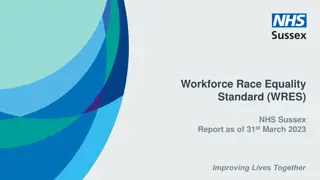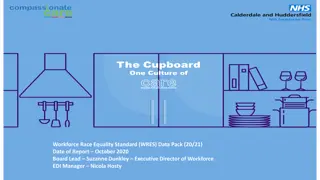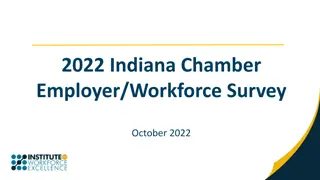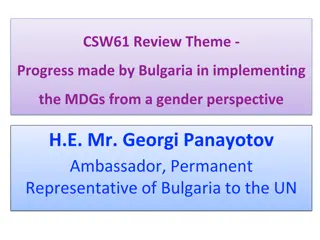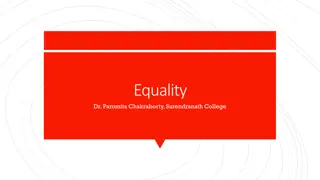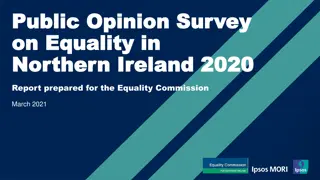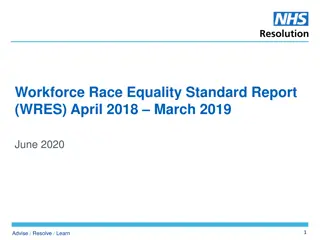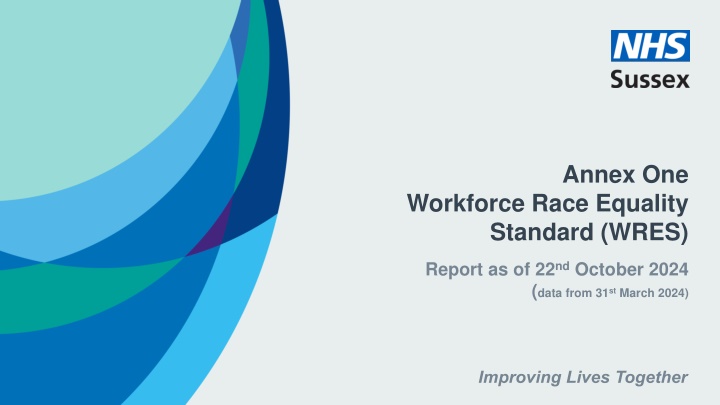
Workforce Race Equality Standard (WRES) Report - NHS Sussex Diversity Statistics
"Discover the latest workforce diversity insights at NHS Sussex, highlighting the growth of ethnically diverse staff, representation trends, and key initiatives to promote equality. Explore key statistics and progress towards an inclusive healthcare environment."
Download Presentation

Please find below an Image/Link to download the presentation.
The content on the website is provided AS IS for your information and personal use only. It may not be sold, licensed, or shared on other websites without obtaining consent from the author. If you encounter any issues during the download, it is possible that the publisher has removed the file from their server.
You are allowed to download the files provided on this website for personal or commercial use, subject to the condition that they are used lawfully. All files are the property of their respective owners.
The content on the website is provided AS IS for your information and personal use only. It may not be sold, licensed, or shared on other websites without obtaining consent from the author.
E N D
Presentation Transcript
Annex One Workforce Race Equality Standard (WRES) Report as of 22ndOctober 2024 (data from 31stMarch 2024)
Introduction Key Highlights: The number and percentage of ethnically diverse staff working in NHS Sussex continues to grow and is broadly representative of the Sussex population. The number and percentage of staff not sharing their status continues to decline. The percentage of non-clinical staff significantly increased in Pay Bands 8C to 9 and VSM from 8% to 13.4%. Our March 2024 data suggests that the relative likelihood of White staff being appointed from shortlisting compared to ethnically diverse staff has improved from 1.72 to 1.28. The number of ethnically diverse staff entering the NHS Sussex formal disciplinary process remains at zero, which is consistent with previous years and compares favourably to the national average of 1.14 The NHS Sussex Board voting membership is well represented with 33.3% of the voting NHS Board Members from an ethnically diverse background. The NHS workforce is now the most diverse in its history, with Black colleagues representing 8.5% of staff, 6.1% of doctors, and 11.8% of nurses, midwives and health visitor. NHS Sussex has undertaken significant work over the last year to reflect and strengthen this national position ensuing that ethnically diverse staff are empowered to thrive in our workforce. This has included a focus on positive action as part of our work to implement the new Targeted Operating Model (TOM) which supports our functions as an Integrated Care Board During the period we have also: Extended the outreach of our Staff Network and now have 64 members of staff as members from across our ethnically diverse workforce. Recruited 42 Diversity Champions to sit on recruitment panels, many of whom are from an ethnically diverse background. Implemented mandatory EDI training for Champions and all recruiting managers. Undertaken EHIAs to support our change programme including staff restructure working with the Network. Note: Due to the implementation of our transformation schedule and the focus on restructuring Bands 8c to 3 over the summer, the WRES report is being presented in October 2024. As a result, there is a possibility that the data may not be fully accurate, and it is submitted with this caveat. Importantly, we have agreed our 2024/25 Workforce Equality, Diversity and Inclusion (EDI) Plan NHS Sussex Workforce EDI plan which sets out objectives and improvement priorities and reports progress six monthly to our Executive Committee. This reflects and integrates our WRES data and the actions we will take to improve our results.
Overall Workforce Diversity in NHS Sussex In the past 12 months the overall number of ethnically diverse staff has increased from 88 to 97, representing 10.4% of staff. Date No. of White staff % of White staff No of Ethnically Diverse Staff % Ethnically Diverse Staff No. of unknown ethnicity % unknown ethnicity The percentage of staff with unknown ethnicity has decreased and is now 7.8% compared to 8.1% in 2023. 666 82% 85 10.5% 31 March 2019 61 7.5% 666 82.5% 89 11% 31 March 2020 52 6.4% The 2021 census data shows 9.0% of Sussex residents identify as ethnically diverse compared to 10.4% of NHS Sussex staff, indicating that NHS Sussex is broadly reflective of the population it serves overall. 707 82% 96 11% 31 March 2021 63 7.4% 759 80.7% 91 9.7% 31 March 2022 90 9.6% These results compare well with the NHS national picture, with Black colleagues representing 8.5% of staff, 6.1% of doctors, and 11.8% of nurses, midwives and health visitor. 781 82.6% 77 8.1% 31 March 2023 88 9.3% 761 81.7% 73 7.8% 31 March 2024 97 10.4%
Ethnic Diversity in NHS Sussex Key Trends The following trends are observable from WRES reporting over the period 2019 to 2024. Increase in the number of ethnically diverse staff: The number of ethnically diverse staff has steadily increased over the years, from 61 in 2019 to 97 in 2024. There has been a corresponding increase in the percentage of ethnically diverse staff in the workforce has also grown, from 7.5% to 10.4%. Decrease in unknown ethnicity status: There has been a decrease in the percentage of staff with unknown ethnicity starting at 10.5% in 2019, reducing to 7.8% in 2024. Comparison with Sussex population: The NHS Sussex ethnically diverse workforce (10.4%) is broadly comparable to the ethnically diverse population of Sussex (9%).
Key Areas of Improvement Key Finding Action Taken Overall, the data shows positive trends in sharing ethnicity status disclosure and representation within NHS Sussex. Review data using refreshed targeted operating model EHIA. Analyse Directorate level representation and consider specific actions to address any notable variance. Continue to encourage colleagues to share ethnicity status particularly at Bands 8b and above. The 2023 survey results show positive results across indicators related to harassment, bullying or abuse compared to white staff and previous years. The 2024 staff survey is now live and the results of this will be reviewed against the 2023 results contained in this report. The NHS Sussex EDI Improvement Plan includes a range of actions that focus on improving the lived experience of our ethnically diverse staff. The Commissioning for Improving Lives Programme will continue to drive improved culture. The percentage of ethnically diverse staff (36.4%) believing the organisation provides equal opportunities for career progression or promotion has worsened considerably, perhaps reflecting anxieties about the restructure. Review data using refreshed targeted operating model EHIA to examine any impact. Deliver ASPIRE and ASPIRING 2024 learning and development programmes.
Indicator 1(A): Percentage of staff in each of the AfC Bands 1-9 or Medical and Dental subgroups and VSM (including executive Board members) compared with the percentage of staff in the overall workforce NON CLINICAL White Staff Ethnically Diverse Staff Unknown ethnicity NHS Sussex % Headcount % Headcount % Headcount The percentage of non- clinical staff has increased or stayed the same for ethnically diverse staff apart from Pay Bands 8C to 9 and VSM where the number of staff increased from 10 to 17. 2021 2022 2023 2024 2021 2022 2023 2024 2021 2022 2023 2024 2021 2022 2023 2024 2021 2022 2023 2024 2021 2022 2023 2024 Pay Bands under 1 and 1 to 4 92% 90% 92%91.7 4.6 % 3.7 % 93 4% >5 4% >5 102 105 100 8% 4% 9 5 5 2% 4% >5 >5 >5 % It should be noted that the percentages are expressed as a percentage of the headcount in the banding groups and not the overall workforce. Pay Bands 5 to 7 Pay Bands 8a to 8b Pay Bands 8c to 9; VSM 82% 81% 82%81.6 8% 10%10.6 7.8 % 184 213 222 208 8% 17 11% 10% 8% 24 22 27 27 27 20 20 % % 83% 77% 80%80.9 5% 11% 11%11.5 7.6 % 128 8 12% 12% 8% 19 97 120 127 14 17 18 15 12 12 % % 79 % 84%81.9 13.4 % 4.7 % 74% 57 103 106 104 12% 12% 8% 9 14% 9% 11 15 10 17 8% 12 10 6 %
Indicator 1(B): Percentage of staff in each of the AfC Bands 1-9 or Medical and Dental subgroups and VSM (including executive Board members) compared with the percentage of staff in the overall workforce - CLINICAL There has been change in the headcount of Bands 8c to 9 and VSM from 7 to 5 with a corresponding decrease from 33.3% to 22.7% White Staff Ethnically Diverse Staff Unknown Ethnicity % Headcount % Headcount % Headcount 2021 2022 2023 2024 2021 2022 2023 2024 2021 2022 2023 2024 2021 2022 2023 2024 2021 2022 2023 2024 2021 2022 2023 2024 It should be noted that the percentages are expressed as a percentage of the headcount in the banding groups and not the overall workforce. As a result of the relatively low headcount in the clinical bandings small reductions or increases can create what appears to be significant variance to the year-on-year results but this may not actually be the case. Pay Band s under 1 and 1 to 4 100% 80% 100% 0 3 0% 0 0% 0 4 1 0 20% 0% 0 1 0 0 0% 0% 0 0 0 0 Pay Band s 5 to 7 85.7 % 86.2 % 86% 87% 132 6% 9 8% 12 132 137 137 7.1% 6% 6.9% 11 9 11 7.1% 7% 6.9% 11 11 11 Pay Band s 8a to 8b 79.5 % 76.3 % 11.5 % 13.2 % 10.5 % 80% 79% 69 10% 9 9% 8 62 65 58 11% 9 9 10 9% 10% 7 8 8 Pay Band s 8c to 9 to VSM 52.33 % 63.6 % 33.3 % 22.7 % 14.33 % 13.6 % 70% 75% 7 0% 0 30% 3 15 11 14 10% 2 7 5 15% 3 3 3
Indicator 2: Relative likelihood of White applicants being appointed from shortlisting across all posts compared to ethnically diverse applicants Our March 2024 data suggests that the relative likelihood of White staff being appointed from shortlisting compared to ethnically diverse staff has improved from and 1.72 to 1.28. Organisation 2020 2021 2022 2023 2024 This is a significant improvement for NHS Sussex, however, there was a reduced volume of recruitment in the period 1st April 2023 to 31st March 2024 due to the change programme. NHS Sussex 2.28 2.02 1.67 1.72 1.28
Indicators Three and Four Indicator 3: Relative likelihood of ethnically diverse staff entering the formal disciplinary process compared to White staff (as measured by entry into a formal disciplinary investigation) The number of ethnically diverse staff entering the NHS Sussex formal disciplinary process remains at zero, which is consistent with previous years and compares favourably to the national average of 1.14. Indicator 4: Relative likelihood of ethnically diverse staff accessing non-mandatory training and continuous professional development (CPD) compared to white staff In April 2024, the relative likelihood of white staff accessing non-mandatory training and CPD compared to ethnically staff is 1.09 times greater, which is a marginal increase to 2023 and reflecting close to equitable access to training. This is further supported by our staff survey data, with ethnically diverse colleagues responding positively to accessing learning and development opportunities.
Indicators 5-8 Staff Survey Indicators The 2023 survey results show positive results across indicators related to harassment, bullying or abuse compared to white staff and previous years. Indicator 2022 Survey 2023 Survey Ethnically Diverse White Ethnically Diverse White Percentage of ethnically diverse staff compared to white staff not experiencing harassment, bullying or abuse in the last 12 months from patients, service users, relatives or members of the public 94.5% 99.1% 94.4% 91% The percentage of ethnically diverse staff (36.4%) believing the organisation provides equal opportunities for career progression or promotion has worsened considerably, perhaps reflecting anxieties about the restructure. Percentage of ethnically diverse staff compared to white staff not experiencing harassment, bullying or abuse in the last 12 months from managers. 91.7% 88.1% 91% 87.7% Percentage of ethnically diverse staff compared to white staff not experiencing harassment, bullying or abuse in the last 12 months from other colleagues. 86.3% 94.1% 90.8% 88% NHS Sussex did not take part in the NHS national staff survey in 2020 & 21, so results for these years are not included. Staff temperature checks were carried out and these results were analysed and actioned in terms of disability. Percentage of ethnically diverse staff compared to white staff believing their trust provides equal opportunities for career progression or promotion. 38.4% 58.2% 36.4% 55.7%
Indicator 9: Percentage of Voting Board Members by Ethnicity NHS Sussex Board Diversity Profile Organisational Status % Ethnically diverse Year % White % Unknown 31 March 2020 62.8% 9.3% 27.9% CCGs 31 March 2021 63.6% 13.6% 22.7% CCGs CCGs 31 March 2022 63.4% 17.11% 19.5% 31 March 2023 ICB 50.0% 33.3% 16.7% ICB 31 March 2024 50.0% 33.3% 16.7% The NHS Sussex Board was established in July 2022 and its overall composition is very different and in line with the national requirements of ICBs. This includes Board members that are representatives of our system partners and therefore not NHS employees whose data cannot be collected for this Indicator. This makes direct comparisons to the data for the previous years difficult however 33.3% of the voting NHS Board Members (which includes both Executive and Non-Executive Directors) were ethnically diverse meaning as at 31st March 2024 there was no change from previous years but good representation of both the ethnically diverse workforce and population.
Next Steps Our EDI Steering Group will continue to oversee our WRES improvement programme as part of our NHS Sussex Workforce EDI Improvement Plan, which brings together all workforce equality improvement activity and is available here:https://www.sussex.ics.nhs.uk/nhs-sussex/our-values/equality- diversity-and-inclusion/ For further information please contact or alternative formats, please contact Our Ethnically Diverse Staff Network (Staff networks - Sussex Health and Care (ics.nhs.uk)) will continue to co-lead this work alongside challenging the organisation where further work or progress is required. Nicky Cambridge, Head of Equality, Diversity and Inclusion We will report progress through the EDI Steering Group and embed the additional actions described in this report into our wider workforce improvement plans to ensure that it is continuously refreshed and reflective of our current WRES indicator position. nicky.cambridge@nhs.net Finally, we will refresh our Targeted Operating Model EHIA to ensure that there have been no disproportionate negative impacts on our ethnically diverse workforce and take action accordingly.

